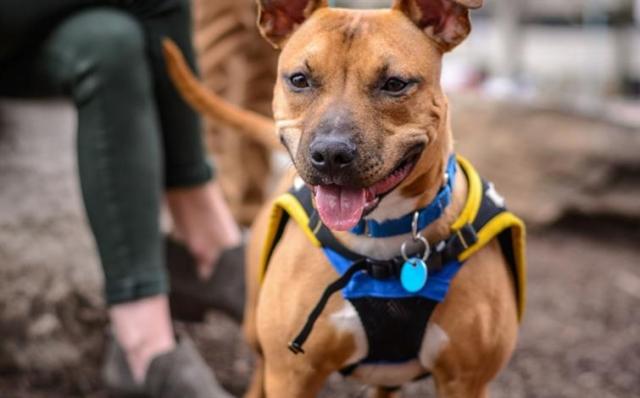People love their pets, and that’s no tall “tail.” But when your beloved dog is of a certain breed, no matter how sweet he is, you may discover that finding a no-breed-restriction apartment is beyond difficult. You may find yourself wondering why your couch potato of a dog is on an “aggressive breeds” list when all he does is watch Netflix with you and beg for your popcorn. There are good reasons behind the bans. And while it seems impossible to find an apartment that will allow your pup, it can be done.
Can Landlords Ban Dog Breeds?
Well yes, and they often do. Apartment communities have to keep the safety of their residents front and center, and that often means banning dogs that are considered aggressive. This, of course, doesn’t apply to service dogs and emotional support dogs – they aid in the quality of life for groups protected by the Fair Housing Act.
Dog breeds often found on aggressive breed lists:
- Pit bull
- Doberman pinscher
- Rottweiler
- German shepherd
- Chow Chow
- Great Dane
- Presa canario
- Akita
- Alaskan malamute
- Siberian husky
- Wolf-hybrid
Why Landlords Are Concerned About Dog Breeds
To be frank (or Fido, however you look at it), landlords have to be concerned about the breed types on their property because of liability reasons. Each year, a large number of dog bite claims are filed with insurance companies. Claims like this can lead to a landlord's liability coverage becoming stricter and they can often be charged a a higher premium as a result of these claims.
According to the Center for Disease Control and Prevention, 1 in 5 people require medical attention after a dog bite. As the amount of submitted medical claims increase, insurance companies often amend their “banned breeds” list. This list is then detailed in a landlord’s liability coverage policy and are omitted from coverage.
Apartment property managers and landlords might not have any control over banned breeds, as many cities and counties have begun enacting breed specific legislation (BSL) laws which restrict certain dog types from the area.
If you’re currently touring apartment communities for a new home or are considering adopting a dog in the near future, a landlord or apartment manager will disclose to you the community’s restricted breeds – and they may apply the ban to dogs mixed with any of the mentioned breeds. You'll find the list of banned breeds in the community's pet policy. If you don't see the pet policy on Apartments.com or on the property website, call and ask them about it.
Your Dog Could Be Called In for a Pet Interview
Some apartment communities judge by the individual dog, and if that's the case, your pet will be called in for a pet interview. A pet interview allows the landlord to meet your pet and make the decision based on the interaction they have rather than the dog's breed.
If you do have a pet interview lined up at an apartment community, here’s what you need to bring to be fully prepared.
1. Doggy Resume
Your dog’s resume should include standard details like the pup’s name, breed, age, weight, vaccination dates, and a current photo. Also, it would be a good idea to include a short snippet about your dog’s personality, what they like to do in their spare time, as well as their favorite treats. Write it in first-person narrative so it sounds like its coming from your dog!
Example:
Hi, I’m Rover,
My mom says I’m a goofball because I chase my tail – I like to think that I’m agile, just burning off energy the way I was taught with my puppy siblings. I like children and they like me, especially when it comes to my floppy ears. My favorite toy is my stuffed squirrel which I would love to show you pup-to-person. When I’m good, I get a chicken-flavored Milk Bone as a treat (yummy!). My mom and I watch The Office together…though I don’t really get the show. Please meet me!
2. Pet Medical Records
Immunization dates for core vaccines like rabies and parvovirus should be a part of your pet’s medical records. Landlords will sometimes keep a copy on file, so they can keep tabs on your pet’s vaccinations.
Other pet medical information they might need:
- Date of spay/neutering procedure
- Date of vaccination for distemper, canine hepatitis, and bordatella
- Name of heartworm and flea/tick preventative
3. Letter of Reference
Bringing a letter of reference written by your dog groomer, pet sitter, or even a neighbor is an excellent way to get a thumbs-up from the landlord on your pet. Be sure the person who writes it includes how your dog behaves when you’re away, leash behavior, and positive interactions with other dogs and kids.
4. Sweet Pup Photos and Videos
You can’t go wrong by showing off the photos and videos of your sweet pup. You might even consider adding a funny photo, like a photo of your dog catching Zzs on the couch with the caption, "I literally do this all day." A little humor can go a long way in a pet interview.
5. Proof of renters insurance or pet liability insurance
To prevent any issues, your landlord might require you to get renters insurance where your pet is covered under liability or get separate pet liability insurance. Bring proof of that so you can show your landlord you are a responsible pet owner.






